人教版九年级英语下册教案Unit 9Unit 9 第1课时
- 格式:doc
- 大小:49.50 KB
- 文档页数:5
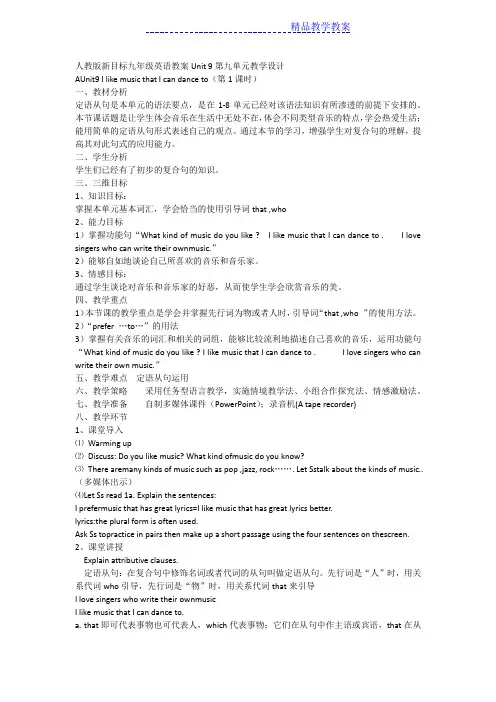
人教版新目标九年级英语教案Unit 9第九单元教学设计AUnit9 I like music that I can dance to(第1课时)一、教材分析定语从句是本单元的语法要点,是在1-8单元已经对该语法知识有所渗透的前提下安排的。
本节课话题是让学生体会音乐在生活中无处不在,体会不同类型音乐的特点,学会热爱生活;能用简单的定语从句形式表述自己的观点。
通过本节的学习,增强学生对复合句的理解,提高其对此句式的应用能力。
二、学生分析学生们已经有了初步的复合句的知识。
三、三维目标1、知识目标:掌握本单元基本词汇,学会恰当的使用引导词that ,who2、能力目标1)掌握功能句“What kind of music do you like ? I like music that I can dance to . I love singers who can write their ownmusic.”2)能够自如地谈论自己所喜欢的音乐和音乐家。
3、情感目标:通过学生谈论对音乐和音乐家的好恶,从而使学生学会欣赏音乐的美。
四、教学重点1)本节课的教学重点是学会并掌握先行词为物或者人时,引导词“that ,who ”的使用方法。
2)“prefer …to…”的用法3)掌握有关音乐的词汇和相关的词组,能够比较流利地描述自己喜欢的音乐,运用功能句“What kind of music do you like ? I like music that I can dance to . I love singers who can write their own music.”五、教学难点定语从句运用六、教学策略采用任务型语言教学,实施情境教学法、小组合作探究法、情感激励法。
七、教学准备自制多媒体课件(PowerPoint);录音机(A tape recorder)八、教学环节1、课堂导入⑴Warming up⑵Discuss: Do you like music? What kind ofmusic do you know?⑶There aremany kinds of music such as pop ,jazz, rock……. Let Sstalk about the kinds of music..(多媒体出示)⑷Let Ss read 1a. Explain the sentences:I prefermusic that has great lyrics=I like music that has great lyrics better.lyrics:the plural form is often used.Ask Ss topractice in pairs then make up a short passage using the four sentences on thescreen. 2、课堂讲授Explain attributive clauses.定语从句:在复合句中修饰名词或者代词的从句叫做定语从句。
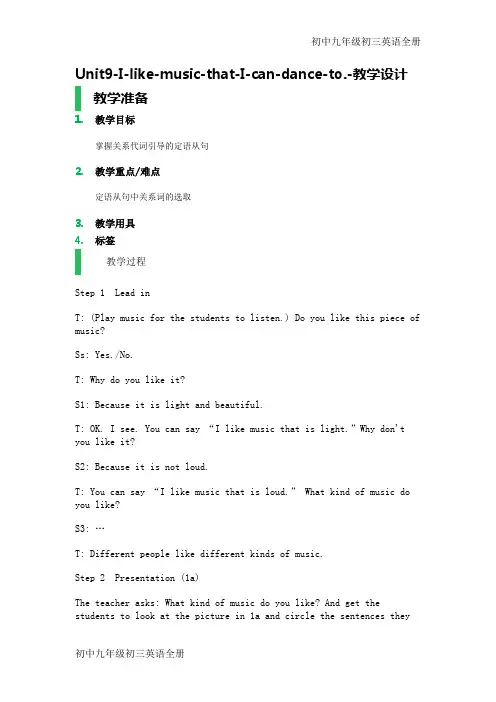
Unit9-I-like-music-that-I-can-dance-to.-教学设计教学准备1. 教学目标掌握关系代词引导的定语从句2. 教学重点/难点定语从句中关系词的选取3. 教学用具4. 标签教学过程Step 1 Lead inT: (Play music for the students to listen.) Do you like this piece of music?Ss: Yes./No.T: Why do you like it?S1: Because it is light and beautiful.T: OK. I see. You can say “I like music that is light.”Why don't you like it?S2: Because it is not loud.T: You can say “I like music that is loud.” What kind of music do you like?S3: …T: Different people like different kinds of music.Step 2 Presentation (1a)The teacher asks: What kind of music do you like? And get the students to look at the picture in 1a and circle the sentences theyagree with. Then write their own sentences. Have them pay attention to the structure of “I like music that…”.Step 3 Listening (1b)(有一定难度,增设听力训练见素材三)1. Listen for the general idea of 1b. (听对话,了解大意)The general idea of the conversation is about ________.A. moviesB. musicC. sports[答案] B2.Listen for the specific ideas of 1b.(听对话,找出关键信息)Get the students to listen and check (√) the kinds of music Tony and Betty like.[答案] Tony: music that has great lyrics; music that I can sing along withBetty: music that I can dance to; music that I can sing along with3.Check their work with several students.Step 4 Pairwork (1c)Have the students make conversations about the music that they like.A: What kind of music do you like?B: I like music that…What about you?A: I prefer music that…Step 5 Presentation (2a)T: Look at the picture in 2a, do you know who they are?S1: Sorry, I don't know.T: One of them is Carmen, and another is Xu Fei. Can you guess the relations between them?S2: Maybe they are classmates.S3: Maybe they are friends.….T: Yes. They are good friends. They always talk about something together. Do you know what they are talking aobut today?Step 6 Listening (2a-2b)1.Have the students listen and circle T for true and F for false in 2a.[答案] 1—4 TFTT2.Ask the students to listen to the tape of 2b and complete the sentences.[答案] 1.who play different kinds of music2.that's loud3.who write their own songs4.that play quiet and slow songsStep 7 Practice (2c)Get the students to make conversations in pairs, using the information in 2a and 2b.e. g.A: Does Xu Fei like…?B: No, he doesn't. He prefers…/Yes, he does. He prefers…Step 8 Roleplay (2d)1.Read for the main idea of 2d.(略读对话,了解大意)The main idea of 2d is ________.A. the weekend activitiesB. summer vacationC. World War Ⅱ[答案] A2.Read for the specific ideas of 2d.(细读对话,掌握关键信息)Name What will he do on the weekend? What kind of music/movies does he like? Why?Scott (1)__________ (2)__________ (3)__________Jill (4)__________ (5)__________ (6)__________[答案] (1)Listen to the new CD he bought.(2)Smooth music.(3)Because it helps him relax after a long week at work.(4)Watch a movie about World War Ⅱ.(5)Serious movies.(6)It can give him something to think about.3.Roleplay the conversation in pairs. Then get some pairs to go to the front of the classroom and perform it to the whole class.Step 9 Language pointsPrefer, suppose课堂小结定语从句,就是用来修饰名词或代词的句子,起到定语的作用。
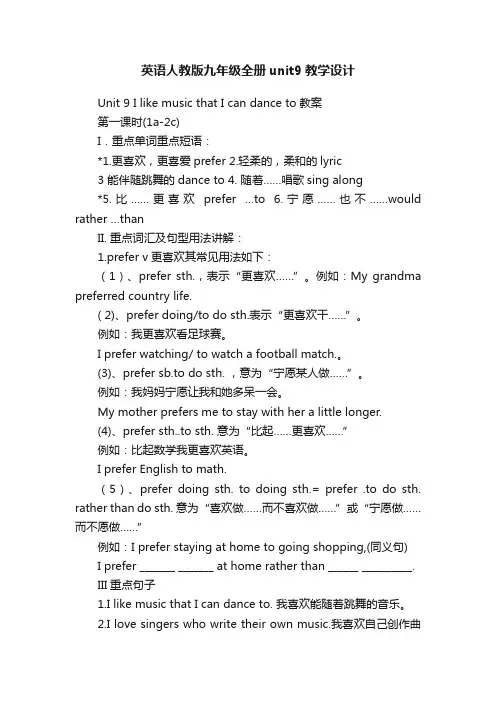
英语人教版九年级全册unit9教学设计Unit 9 I like music that I can dance to教案第一课时(1a-2c)I.重点单词重点短语:*1.更喜欢,更喜爱prefer 2.轻柔的,柔和的lyric3 能伴随跳舞的dance to 4. 随着……唱歌sing along*5.比……更喜欢prefer …to 6.宁愿……也不……would rather …thanII. 重点词汇及句型用法讲解:1.prefer v更喜欢其常见用法如下:(1)、prefer sth.,表示“更喜欢……”。
例如:My grandma preferred country life.( 2)、prefer doing/to do sth.表示“更喜欢干……”。
例如:我更喜欢看足球赛。
I prefer watching/ to watch a football match.。
(3)、prefer sb.to do sth. ,意为“宁愿某人做……”。
例如:我妈妈宁愿让我和她多呆一会。
My mother prefers me to stay with her a little longer.(4)、prefer sth..to sth. 意为“比起……更喜欢……”例如:比起数学我更喜欢英语。
I prefer English to math.(5)、prefer doing sth. to doing sth.= prefer .to do sth. rather than do sth. 意为“喜欢做……而不喜欢做……”或“宁愿做……而不愿做……”例如:I prefer staying at home to going shopping,(同义句)I prefer _______ _______ at home rather than ______ __________.III重点句子1.I like music that I can dance to. 我喜欢能随着跳舞的音乐。
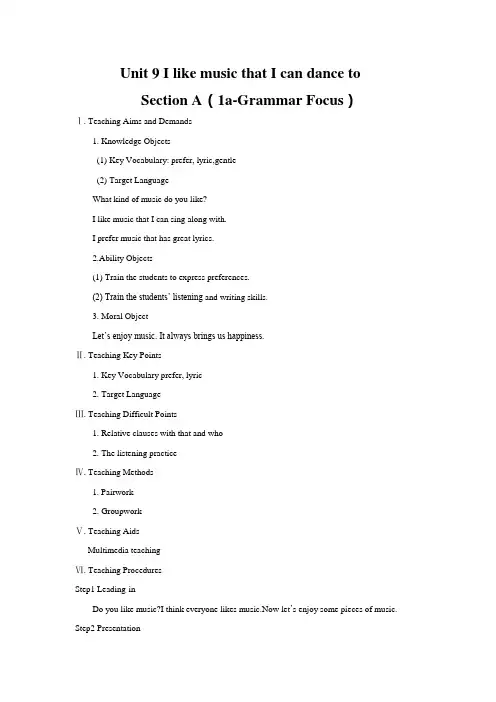
Unit 9 I like music that I can dance toSection A(1a-Grammar Focus)Ⅰ. Teaching Aims and Demands1. Knowledge Objects(1) Key Vocabulary: prefer, lyric,gentle(2) Target LanguageWhat kind of music do you like?I like music that I can sing along with.I prefer music that has great lyrics.2.Ability Objects(1) Train the students to express preferences.(2) Train the students’ listening and writing skills.3. Moral ObjectLet’s enjoy music. It always brings us happiness.Ⅱ. Teaching Key Points1. Key Vocabulary prefer, lyric2. Target LanguageⅢ. Teaching Difficult Points1. Relative clauses with that and who2. The listening practiceⅣ. Teaching Methods1. Pairwork2. GroupworkⅤ. Teaching AidsMultimedia teachingⅥ. Teaching ProceduresStep1 Leading-inDo you like music?I think everyone likes music.Now let’s enjoy some pieces of music.Step2 PresentationPlay a piece of music.Then ask the students:Do you like the music?What do you think ofit?Help the students to answer it.Then say , I like music that I can dance to.In this way,play some other kinds of music for the students and let them try to say “Ilike/prefer music that has great lyrics,…that I can sing along with,…that isn’t too loud, …”. Tell the students prefer means like …better.(设计意图:先描述对各种音乐的感觉,引导学生学会用定语从句表达自己喜欢的各种音乐。
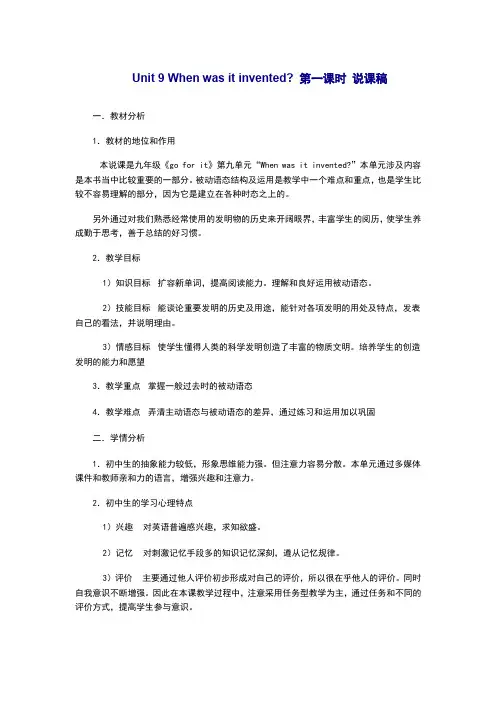
Unit 9 When was it invented? 第一课时说课稿一.教材分析1.教材的地位和作用本说课是九年级《go for it》第九单元“When was it invented?”本单元涉及内容是本书当中比较重要的一部分。
被动语态结构及运用是教学中一个难点和重点,也是学生比较不容易理解的部分,因为它是建立在各种时态之上的。
另外通过对我们熟悉经常使用的发明物的历史来开阔眼界,丰富学生的阅历,使学生养成勤于思考,善于总结的好习惯。
2.教学目标1)知识目标扩容新单词,提高阅读能力。
理解和良好运用被动语态。
2)技能目标能谈论重要发明的历史及用途,能针对各项发明的用处及特点,发表自己的看法,并说明理由。
3)情感目标使学生懂得人类的科学发明创造了丰富的物质文明。
培养学生的创造发明的能力和愿望3.教学重点掌握一般过去时的被动语态4.教学难点弄清主动语态与被动语态的差异,通过练习和运用加以巩固二.学情分析1.初中生的抽象能力较低,形象思维能力强。
但注意力容易分散。
本单元通过多媒体课件和教师亲和力的语言,增强兴趣和注意力。
2.初中生的学习心理特点1)兴趣对英语普遍感兴趣,求知欲盛。
2)记忆对刺激记忆手段多的知识记忆深刻,遵从记忆规律。
3)评价主要通过他人评价初步形成对自己的评价,所以很在乎他人的评价。
同时自我意识不断增强。
因此在本课教学过程中,注意采用任务型教学为主,通过任务和不同的评价方式,提高学生参与意识。
3.初三上学期学生有较明确的学习动机和态度。
本单元通过发明为载体,各种发明和发明家激励学生求知的欲望。
三.教法渗透1、教学设计思路与教材处理:《新目标英语》中的具体语言目标是通过各种各样的Tasks来实现的;学生需要运用具体而特定的行动来完成一定的交际任务。
整个教学过程中,各种语言结构与语言功能与不同的学习任务有机的结合。
任务活动所谋求的效果不是一种机械的语言训练,而是侧重在执行任务中学生自我完成任务的能力和策略的培养;重视形式在完成任务过程中的参与和在交流活动中所获得的经验。

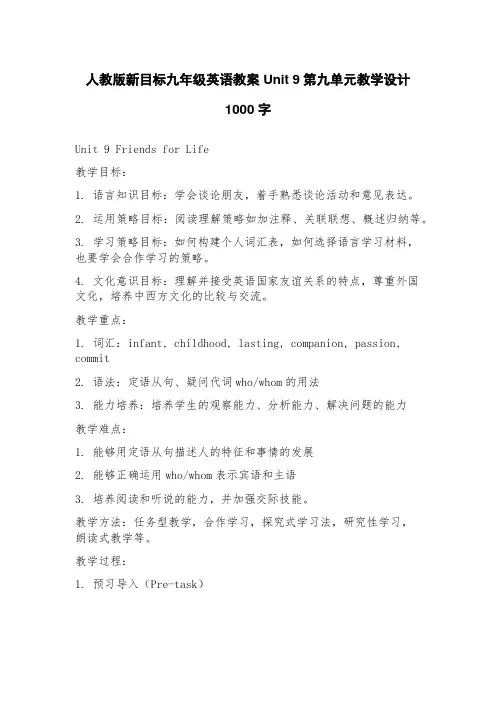
人教版新目标九年级英语教案Unit 9第九单元教学设计1000字Unit 9 Friends for Life教学目标:1. 语言知识目标:学会谈论朋友,着手熟悉谈论活动和意见表达。
2. 运用策略目标:阅读理解策略如加注释、关联联想、概述归纳等。
3. 学习策略目标:如何构建个人词汇表,如何选择语言学习材料,也要学会合作学习的策略。
4. 文化意识目标:理解并接受英语国家友谊关系的特点,尊重外国文化,培养中西方文化的比较与交流。
教学重点:1. 词汇:infant, childhood, lasting, companion, passion, commit2. 语法:定语从句、疑问代词who/whom的用法3. 能力培养:培养学生的观察能力、分析能力、解决问题的能力教学难点:1. 能够用定语从句描述人的特征和事情的发展2. 能够正确运用who/whom表示宾语和主语3. 培养阅读和听说的能力,并加强交际技能。
教学方法:任务型教学,合作学习,探究式学习法,研究性学习,朗读式教学等。
教学过程:1. 预习导入(Pre-task)通过显示26个英文字母,让学生回忆并列出所有以字母“F”开头的词汇,包括名词、形容词和动词。
教师在课堂前五分钟录下结果。
集体看一看,并补全缺少的词汇。
2. 输入新信息(Input)(1)任务1 完形填空让学生看到P63-P64的Team Building后,完成练习。
(2)任务2 阅读理解让学生阅读第一篇文章。
找到文章中描述朋友关系的词句,把它们圈起来。
(只用一分钟)接着,再读文章一遍,用自己的话回答问题。
(3)任务3 语法:定语从句a. 回忆练习:请学生跟随老师大声读一遍P66中的例句,并在课本上用横线把定语从句圈出来。
b. 给出Grammars P93中的定语从句。
分类规定。
c. 设计练习。
请学生阅读P93中的定语从句,并按照汉语意思,写出英语句子。
例如:我能听懂讲师讲英语的课。
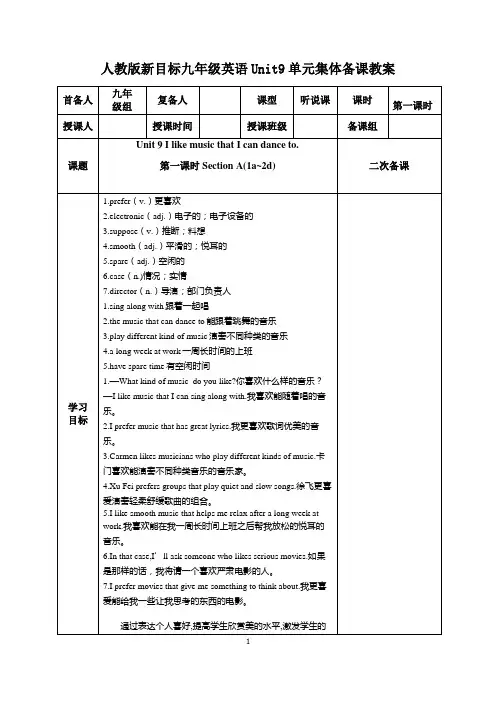
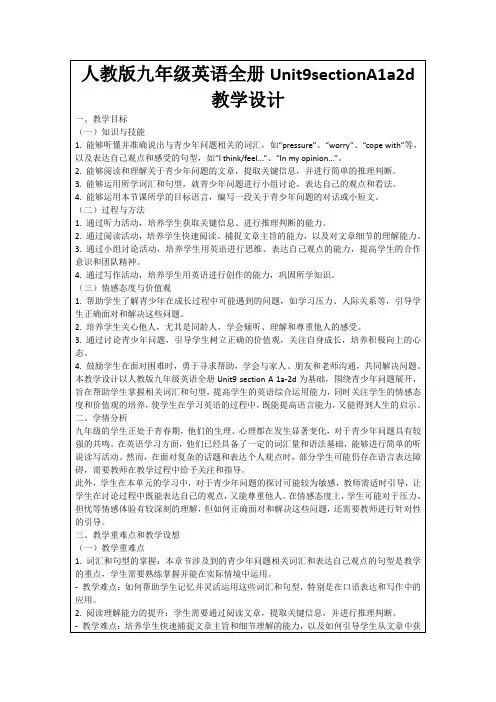
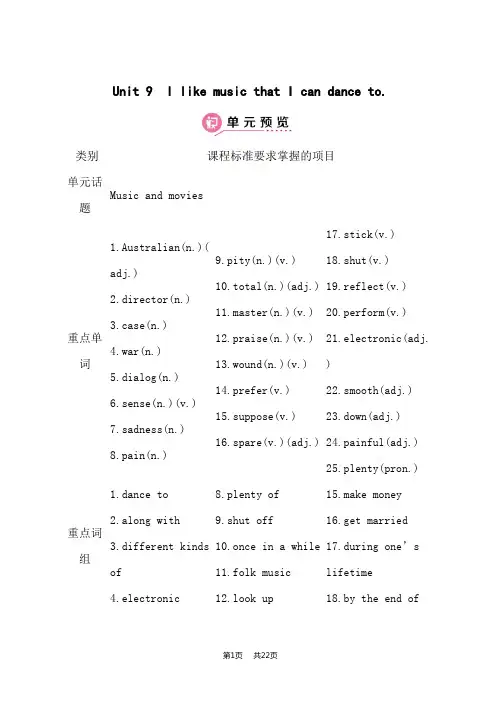
Unit 9 I like music that I can dance to.类别课程标准要求掌握的项目单元话题Music and movies重点单词1.Australian(n.)(adj.)2.director(n.)3.case(n.)4.war(n.)5.dialog(n.)6.sense(n.)(v.)7.sadness(n.)8.pain(n.)9.pity(n.)(v.)10.total(n.)(adj.)11.master(n.)(v.)12.praise(n.)(v.)13.wound(n.)(v.)14.prefer(v.)15.suppose(v.)16.spare(v.)(adj.)17.stick(v.)18.shut(v.)19.reflect(v.)20.perform(v.)21.electronic(adj.)22.smooth(adj.)23.down(adj.)24.painful(adj.)25.plenty(pron.)重点词组1.dance to2.along with3.different kindsof4.electronic8.plenty of9.shut off10.once in a while11.folk music12.look up15.make money16.get married17.during one’slifetime18.by the end ofmusic5.in that case6.stick to7.cheer up 13.musicalinstrument14.be known for19.in total20.not only…butalso重点句式1.I like music that I can sing along with.2.I prefer music that has great lyrics.3.If you have spare time,do you want to watch a movie with me?4.I prefer movies that give me something to think about.5.I like to watch different kinds depending on how I feel that day.6.When I’m down or tired,I prefer movies that can cheer me up.7.The characters may not be perfect,but they try their best to solve their problems.ughing for two hours is a good way to relaas or documentaries when I’m sad or tired.10.They can be fun,but I’m too scared to watch them alone.11.I like movies that are sad.12.The piece which was played on the erhu especially movedme.13.The erhu sounded so sad that I almost cried along withit as I listened.14.I began to understand the sadness in the music.15.His mother died when he was very young.16.Abing’s father taught him to play many musicalinstruments.17.For several years,he had no home.18.He performed in this way for many years.19.Abing’s amazing musical skills made him very popularduring his lifetime.20.It is a pity that only siusic in total were recorded forthe future world to hear.单元语定语从句的用法法第一课时Section A(1a~2d)重点单词prefer(v.) 更喜欢Australian(adj.) 澳大利亚(人)的 (n.) 澳大利亚人electronic(adj.) 电子的;电子设备的suppose(v.) 推断;料想smooth(adj.) 悦耳的;平滑的spare(adj.) 空闲的;不用的 (v.) 抽出;留出director(n.) 导演;部门负责人case(n.) 情况;实情war(n.) 战争;战争状态重点词组dance to随着……起舞along with连同……一起different kinds of不同种类的electronic music电子音乐in that case既然那样;假使那样的话重点句式I like music that I can sing along with.我喜欢能随着一起唱的音乐。
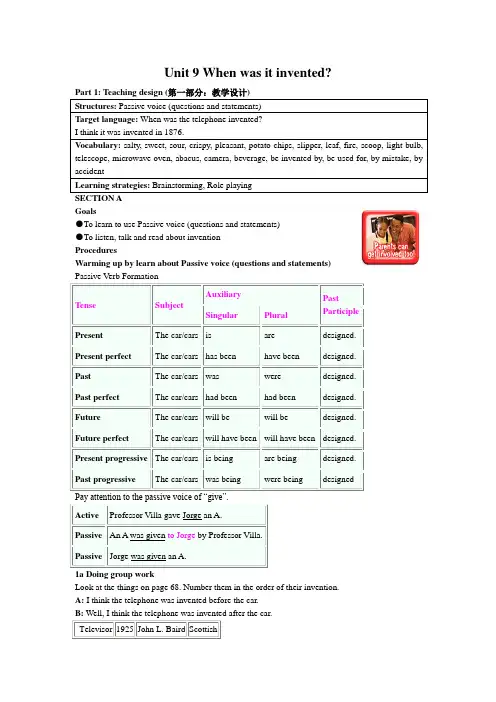
Unit 9 When was it invented?Goals●To learn to use Passive voice (questions and statements)●To listen, talk and read about inventionProceduresWarming up by learn about Passive voice (questions and statements)1a Doing group workLook at the things on page 68. Number them in the order of their invention. A: I think the telephone was invented before the car.A: I think the televisor was invented before the computer.A: I think the calculator was invented before the plane.B: Well, I think the calculator was invented after the planer.1b Listening and matchingNow you are going to read the listening tapescript. Blacken the passive voice, circle all the linking words and underline all the useful expressions.1c Doing pairworkIn pairs, one covers the dates and the other asks him when the things in the pictures on page 68Next you are going to listen to a tapescript and number the inventions in the order that you hearThe inventions are heard in the following order.battery-operated slippers→heated ice cream scoop→shoes with adjustable heels2b Listening and matchingYou shall listen to the recording again and match the items in the chart on page 69 in columns A,Role play the conversations using the information in the chart in the middle of page 69. PayThere are two kinds of inventions. One is helpful invention, and the other is annoying invention.3b Doing pairwork4 Doing groupworkImagine you are left alone on a small island in the sea. If you are allowed to take five inventionsGoals●To learn to use passive voice (questions and statements)●To read about teaProceduresWarming up by making passive sentencesHello, everyone. This week we learn to use passive voice (questions and statements). Now we1a Looking and writingOn page 71 you will find some adjectives used to describe how food tastes. Look at the pictures1b Writing the namesOn page 71 you will find in the box some adjectives used to describe food. Now read each of them and write the name of a different food after each of them.Sweet apple→crispy crackers→salty water→sour rice2a Listening and circling2b Listening and completing2c Doing pairworkNext you are going to role play the conversations about the invention of the potato chip. Use theNow let’s rea d to find out who invented tea. While you read, circle all the linking words and3b Writing an articleOn page 72 you will find notes in the box on the left. Write an article using the notes about theWe all have things that we don’t liking doing. Why not think of an invention that could help you.4b Doing pairworkIn pairs ask each other questions about inventions, and try to sell your invention to your partner.Closing down by talking about inventionInvention: abacus in c3000 BCInvention: abacusFunction: A counting device: a mechanical device for making calculationsconsisting of a frame mounted with rods along which beads or balls are movedNationality: ChineseInvention: Coca-Cola in 1886Definition: noun / trademarkFunction: Popular carbonated soft drink colored usually with caramel and flavored usually with extracts from kola nuts and sweetenersTrademark: U.S. issued 1893Inventor: John Stith PembertonCriteria; First to invent. Entrepreneur.Birth: July 8, 1831 in Rome, GeorgiaDeath: August 16, 1888 in Columbus, GeorgiaNationality: AmericanSELF CHECK1 Filling blanksintroduced aLook at the pictures below and tell about what you see. Use as many examples of passive voice (questions and statements) as possible.Reading: Do you know when basketball was invented?Before you read, listen and read aloud to the recording of passage. Make your reading as close to the recording as possible.While you readI.What is invention?An invention is a new thing that someone has made. The computer was an invention when it was first made. We say when it was "invented". New things that are made or created are called inventions. The car is an invention that everyone knows.Ideas are also called inventions. Writers can invent characters, and then invent a story about them. II. What is an inventor?An inventor is a person who creates new inventions, typically technical devices such as mechanical, electrical or software devices or methods. Although some inventors may also be scientists, most of them are engineers in fact as they base their work on the discoveries of other scientists, experimenting with practical applications and combinations of those discoveries, and with improvements and combinations of existing devices, to create new useful devices.The system of patents was established to encourage inventors by granting limited-term monopoly on inventions that are judged sufficiently novel. This system is nowadays frequently considered as being abused, especially in the United States, and some have called for reform or even abolition of the patent system. In the U.S., however, the patent right originates from the Constitution, so inventors will likely continue to protect their inventions that way for many years to come.The capacity to invent can be developed. See TRIZ, the theory of inventive problem-solving.。
Unit 9I like music that I can dance to.教学设计知识目标课堂环节§自主学习案翻译下列词组。
1.伴随着……唱sing__along__with2.和着……节拍跳dance__to3. 演奏不同种类的音乐play__different__kinds__of__music4.电子音乐electronic__music5.悦耳优雅的音乐smooth__music6.有空闲时间have__spare__time7.既然那样in__that__case8.考虑,思考think__about9.喜欢……胜过……prefer…to…§课堂导学案Step 1 准备与热身(Preparation)T :Do you love music? Yeah, music is also my favorite.It makes my life more colorful.You know, there are different kinds of music in the world.教师播放学生较熟悉的带有歌词或歌手的图片的流行歌曲,激发学生的学习兴趣,同时师生对话,引出本单元的内容学习,为完成1a做铺垫。
T: Do you like music/…?S: Yes, I do.T: What kind of music /…do you like?S: I like…T: Which singer do you like?S: I like…Present some new words and the attributive clause at the same time.Step 2 呈现与输入(Presentation)1.要求学生翻开课本P65,迅速阅读1a部分的内容。
并按要求完成课本上相应的任务。
(1分钟)2.核对答案,先要求全班一起给出答案并检查讨论。
然后要求2-3名同学就“I like music that__.”给出自己的答案,并把收集的答案列举在黑板上。
Unit 9 I like music that I can dance to.Section A (1a-2d)单词prefer,Australian,electronic,1.重点短语和句型。
2.定语从句。
定语从句。
Step 1复习:向同学们介绍一个你知道的未解之谜。
Step 2情景导入:T:Do you love music? Yeah, music is also my favorite. It makes my life more colorful. You know, there are different kinds of music in the world. (Play some beautiful music and let students talk about it freely.)T:What kind of music do you prefer?S:1.I like loud music. I can dance to it.2.I like quiet music.环节说明:通过课前的师生互动引入新课的话题。
Step 3完成教材1a-1c中的任务:1.你喜欢什么类型的音乐呢?在1a的图片中圈出你喜欢的音乐类型,然后写出符合自己实际情况的句子。
2.听录音,勾出托尼和贝蒂喜欢的音乐类型,将1b中的表格填写完整。
3.再听一遍录音,并跟读对话。
4.两人一组,练习1c中的对话,然后仿照1c的形式和你的搭档谈论各自喜欢的音乐类型。
5.小结训练根据汉语意思完成句子(1)你喜欢什么样的音乐?What of music do you ?(2)我喜欢有着美妙歌词的音乐。
I like music has great .(3)我的朋友们更喜欢能够随之跳舞的音乐。
My friends music that they can dance to.(4)这位美国老太太喜欢能够随之唱的音乐。
The old American lady loves music she can sing with.答案:(1)kind; like(2)that; lyrics(3)prefer(4)that; alongStep 4完成教材2a-2d中的任务1.读2a中的句子,听录音,根据录音内容判断句子的正误。
Unit9 Section A 第一课时教案教学目标1To learn to understand and use relative clauses with that and who2 To listen and speak about music that you like3 To listen and speak about people who you like学习由关系代词who,that引导的定语从句,并且能运用它们描述自己的喜好。
教学设计导入教师与学生谈论天气。
板书:I like weather that is sunny, too.教师问另外的学生,引导学生以I like weather that is warm/cool…句型进行练习。
3.展示多姿多彩的时装和各种不同的菜式的图片,和学生谈论衣服、食物等。
运用句型:What kind of clothes do you like? I like clothes that are comfortable/soft/not expensive.说明:以旧带新,引入新课,通过对学生的逐一操练,让学生在轻松的环境中接受新知识——that 引导的定语从句。
二、教学SectionA- 1a1.播放学生熟悉的带有歌词的流行歌曲,用一首悠扬抒情的音乐和一曲热情奔放的音乐,引出新词lyrics/gentle/energy。
利用媒体资源中课件中的内容,让学生学习新词。
2.让学生交流他们对一些歌曲的看法。
运用黑板上的句型:板书:What kind of music do you like?I like music that is gentle.I like music that I can dance to.I like music that I can sing along with.I like music that has great lyrics.3.A survey让每组每个学生分别问其他5个学生关于音乐的爱好,然后写他们所说的句子,如:Mary like music that she can sing along with,再得出结论,最后全班同学的结果展示给大家。
Unit 9 I like music that I can dance toSection A (1a-1c)Yucai Middle School Wang LiThe First PeriodⅠ. Teaching Aims and Demands1. Knowledge ObjectsKey Vocabulary: prefer, lyric2. Ability ObjectsTrain the students to express preferences. Ⅱ. Teaching Key Points1. Key Vocabulary :prefer, lyric2. Target LanguageA: what kind of music do you like?B:I like music that has great lyrics.B:I love music that I can sing along with.B:I like music that isn’t too loud.B:I prefer music that I can dance to.Ⅲ. Teaching Difficult Points1. Relative clauses with that2. The listening practiceⅣ. Teaching ProceduresStep1: Lead-inPlay some different kinds of music and ask:What kind of music do you know?Do you like it?What do you think of this music?What kind of music do you prefer?PresentationI like music that I can dance to.I prefer music that has great lyrics.She dislikes music that is too loud.He likes music that he can sing along with.……Step2 Finish 1a让学生在小组内交流讨论自己的喜好,教师适时总结让学生交流对一些歌曲的看法,写下句子并引出本节课的重点句型。
Unit 9I like music that I can dance to. 单元目标
第一课时Section A(1a-2d)
课时目标
自主学习
根据句意及音标提示写出单词及其汉语意思。
1.The Smiths __prefer__/prɪˌfɜː(r)/ sending e-mails to writing letters,because it is faster.__更喜欢__
2.The girl likes the song very much.The __lyrics__/ˌlɪrɪks/ of it express her thoughts and feelings.__歌词__
3.__Australian__/ɒˌstreɪliən/ seasons are different from ours.__澳大利亚的__
4.Some people read books on __electronic__/ɪˌlekˌtrɒnɪk/ reading devices.__电子的__ 5.Quiet and __smooth__/smuːð/ music helps people relax after a busy day.__悦耳的;平滑的__
教学过程
环节1新课导入
T:Hello,everyone!In this lesson we will learn something about music.So please tell me your favourite music or singers and tell me why.
S1:My favourite singer is...because...
…
设计意图:师生通过问答的方式,将话题引入到本课时的学习内容中去,为后文的学习做好铺垫。
环节2学习1a-1c
1.让学生大声朗读1a图片中的句子,并按自己的喜好仿写句子,最后请几位同学分享一下他们的音乐偏好。
2.让学生查看1b中的内容,播放录音,完成任务。
3.再播放一遍录音,学生逐句跟读,整体感知,并对自己的答案进行校验,最后老师核对答案。
4.学生两人一组模仿1c中的句子,就自己喜欢的音乐展开对话并进行演绎,然后老师抽选几组学生当堂表演对话。
设计意图:听力练习训练了学生抓取关键信息的能力,同时使其对本单元的主题和定语从句有了初步了解。
对话练习让学生通过合作的方式用目标语言进行表达,对听力和口语都有帮助。
环节3学习2a-2d
1.让学生查看2a中的句子,预测听力内容,然后播放录音,完成任务。
2.再次播放录音,让学生完成2b中的表格。
3.再播放一遍录音,学生逐句跟读,整体感知,最后老师核对2a和2b的答案。
4.学生活动。
以2c中的对话为例,让学生根据2a和2b的信息,两两一组作对话练习,老师抽取几组学生当堂表演对话。
5.学生先浏览2d的对话,总结对话的主题,勾画出生词、重点短语及难句。
6.播放2d的录音,学生逐句跟读,把握对话的细节,模仿对话者的语音语调。
7.结对练习,让学生分角色表演该对话。
8.要点点拨。
(1)Xu Fei prefers groups that play quiet and slow songs.
prefer v.更喜欢。
其现在分词形式为preferring,过去式和过去分词均为preferred。
主要
用法如下:
①后接不定式或动名词。
表示一般情况用动名词,表示特定动作用不定式。
②prefer...to...意为“与……相比,更喜欢……”,多用于比较两个名词或动名词。
③prefer to do sth.rather than do sth.意为“喜欢……更胜于/而不喜欢……”。
例:He prefers to read rather than watch television.他喜欢读书而不喜欢看电视。
(2)I suppose I'll just listen to this new CD I bought.
“I suppose+that从句”意为“我猜测/假定……”,本句省略了that。
若要变为否定句,和think、believe等词后的宾语从句一样,从句的否定要转移到主句,即“否定转移”。
此外,对“Do you suppose...?”疑问句的肯定回答用“Yes,I suppose so”,否定回答用“No,I suppose not”。
【拓展】be supposed to do sth.意为“被期望/要求做某事;该做某事”,含必须、应该做某事之意,相当于should。
(3)Hmm,depends which movie.
①本句省略了depends前的主语it和which movie后的定语从句部分we'll watch,是典型的口语表达形式。
在口语和非正式场合,为保持语言简洁明了,交流者往往会省略彼此所知或逻辑上可明确推断出的内容。
②It depends (on) who/what/how/whether...是一个常见句型。
当depend后接疑问词及含有疑问词的短语和从句时,为求话语简练,口语中会省略depend后的介词on。
9.学以致用。
(根据汉语意思完成句子,一空一词。
)
(1)比起红色,他更喜欢蓝色。
He __prefers__ __blue__ __to__ __red__.
(2)学生应当每天放学后多运动。
Students __are__ __supposed__ __to__ __do__ more sports after school every day.
(3)我认为我的朋友不能完成这项工作。
I __don't__ __suppose/think__ that my friend __can__ finish the work.
(4)健康取决于好的食物、新鲜的空气和充足的睡眠。
Health __depends__ __on__ good food,fresh air and enough sleep.
(5)那个穿红裙子的女孩是我最好的朋友简。
The girl __who__ __is__ in a red skirt __is__ my best friend Jane.
板书设计
练习设计
请完成本课对应训练!。